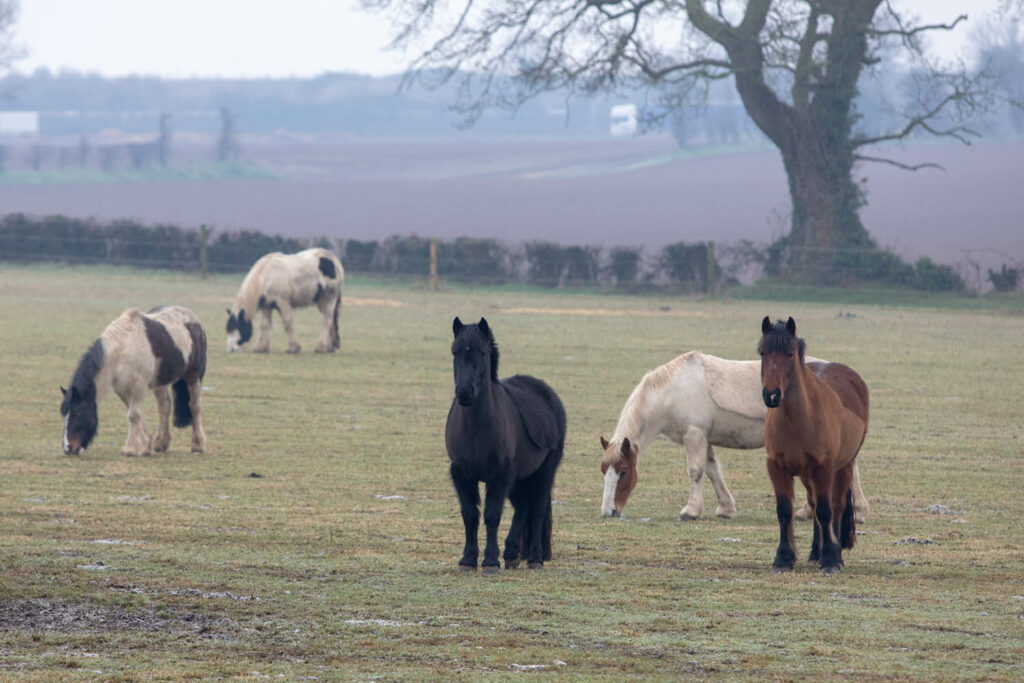It is essential to continuously monitor horse’s health and welfare throughout the year and regardless of the season, it is important that all farriery, veterinary and dental care is kept up to date.
During winter, owners need to be mindful of the weather and consider their horse’s age, breed, size, diet, coat (clipped/not clipped) and what type of shelter is available.

Top ten tips for caring for horses in winter
- Treat each horse, pony or donkey as an individual
- Check your horse regularly for any changes in body weight by using a weighbridge or weigh tape and assessing their body condition using fat scoring
- Provide ad-lib access to good quality forage at all times and especially during cold weather
- If your horse is overweight, vary how they can access forage (e.g., slow feeders, small-holed hay nets) to slow down consumption rate whilst ensuring ad-lib access
- Make sure your horse has access to a shelter – either natural or man-made – and remember donkeys need a fully waterproof shelter
- Don’t rug horses based on how cold you are, but whether they actually need to be rugged – be careful not to over-rug your horse as it could lead to discomfort, weight gain or development of skin conditions
- If you do need to rug your horse, use a rug that fits properly and have a spare in case one gets wet
- Keep a close eye on your horse’s legs and coat for early signs of mud fever or other skin conditions
- Make sure fresh water is always available, and remember in freezing conditions you may need to check the water trough or bucket two or three times a day to break and remove any ice
- Have some sand available to use on icy paths
What temperatures are horses comfortable in?
It is important to remember, horses don’t feel the cold in the same way that we do. The temperature range that a healthy adult horse will feel comfortable in, where they can regulate their own body temperature is between 5°C and 25°C.
When the temperature drops below 5°C horses need to find ways to warm themselves up, which they do by eating more forage, seeking shelter, reducing the blood flow to the limbs (to reduce heat loss), increase movement and shivering. Your horse’s legs, ears or face are not the best areas to use to assess how cold they are, instead feel across their neck, withers and body. Their age including if they are very young or old may be affect how they feel the cold. Whether they are clipped may also affect how they feel the cold and you then need to decide whether they need to wear an appropriate rug.
Do I need to rug my horse in the winter?
Key considerations when rugging horses:
- Inappropriate rugging can cause rubbing and injury, as well as increasing the risk of skin conditions
- If your horse is clipped, then you may need to use a rug to prevent weight loss and keep your horse comfortable if temperatures fall below 5°C
- If done carefully, a small clip such as the neck and belly area can be used without rugging as a method of weight loss
- If your horse has little body fat (a fat score of less than two on a scale of 0 to 5) speak to your vet about their health and welfare, and use a rug if temperatures drop
- Always have a spare rug available so you can swap them if one gets very wet
- It’s important to remove and re-adjust rugs every day so you can check your horse thoroughly
- Try to allow rugged horses time during the day to get fresh air and the sun on their backs on warmer or dry days – don’t keep them rugged 24/7
- Be careful not to over-rug your horse as they may sweat and become uncomfortable.
How to care for your horse’s legs in mud, snow and ice
In deep snow or mud, your horse’s legs are not able to fully dry off, which can cause skin conditions such as mud fever. Make sure you thoroughly check their legs and hooves daily for signs of disease or infection. Apply petroleum jelly to the underneath of the horse’s hooves – particularly during exercise – to prevent snow balling up. Remember to remove it all afterwards as it can be a breeding ground for bacteria in warmer conditions.
Popular advice in Environment

Pasture management for horse paddocks
Find out how to manage your paddock for the health of your horse, pasture and soil.

Ragwort: how to deal with it in a horse paddock
Find out how to recognise ragwort and the best ways to remove it.
Other advice categories
All webinar categories:
Call our Advice Line
+44 (0)1953 497 238Not found the advice or answer you were looking for here? Then our Advice Line is available during office hours, or you can email us on education@worldhorsewelfare.org to let us know what topics you were looking for.


